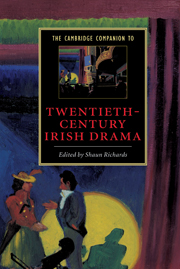Book contents
- Frontmatter
- 1 Plays of (ever) changing Ireland
- 2 Late nineteenth-century Irish theatre: before the Abbey – and beyond
- 3 The ideology of the Abbey Theatre
- 4 The theatre of William Butler Yeats
- 5 Lady Gregory’s Abbey Theatre drama: Ireland real and ideal
- 6 J. M. Synge, ‘national’ drama and the post-Protestant imagination
- 7 On the siting of doors and windows: aesthetics, ideology and Irish stage design
- 8 Oscar Wilde and the politics of style
- 9 George Bernard Shaw and Ireland
- 10 Sean O’Casey’s Dublin Trilogy: disillusionment to delusion
- 11 Ireland’s ‘exiled’ women playwrights: Teresa Deevy and Marina Carr
- 12 Samuel Beckett and the countertradition
- 13 Brian Friel’s sense of place
- 14 The Field Day Theatre Company
- 15 Tom Murphy and the children of loss
- 16 Reconstructing history in the Irish history play
- 17 The Abbey Theatre and the Irish state
- 18 Staging contemporary Ireland
- 19 The Revival revised
- Guide to further reading
- Index
- Series List
15 - Tom Murphy and the children of loss
Published online by Cambridge University Press: 28 May 2006
- Frontmatter
- 1 Plays of (ever) changing Ireland
- 2 Late nineteenth-century Irish theatre: before the Abbey – and beyond
- 3 The ideology of the Abbey Theatre
- 4 The theatre of William Butler Yeats
- 5 Lady Gregory’s Abbey Theatre drama: Ireland real and ideal
- 6 J. M. Synge, ‘national’ drama and the post-Protestant imagination
- 7 On the siting of doors and windows: aesthetics, ideology and Irish stage design
- 8 Oscar Wilde and the politics of style
- 9 George Bernard Shaw and Ireland
- 10 Sean O’Casey’s Dublin Trilogy: disillusionment to delusion
- 11 Ireland’s ‘exiled’ women playwrights: Teresa Deevy and Marina Carr
- 12 Samuel Beckett and the countertradition
- 13 Brian Friel’s sense of place
- 14 The Field Day Theatre Company
- 15 Tom Murphy and the children of loss
- 16 Reconstructing history in the Irish history play
- 17 The Abbey Theatre and the Irish state
- 18 Staging contemporary Ireland
- 19 The Revival revised
- Guide to further reading
- Index
- Series List
Summary
In 1968 Tom Murphy's play Famine was staged in Dublin's Peacock Theatre. It was an audacious act of theatrical imagination to represent, in the Irish national theatre's tiny studio space, Ireland's greatest historical disaster. In Murphy's play one family, one village, stand in for the experience of the nation. Famine opens with a split scene. The community is mourning the death of a young daughter of the Connor family with the formal rituals of the wake and the keen. At the same time, on the edge of that scene, the men exchange uneasy, disconnected remarks about the potatoes:
Mark (nervous staccato voice). But – but – but, ye see, last year the first crop failed but the main crop was good, and this year the first crop failed, but the main crop will be – will be – will be . . .
Dan. Hah?
Brian. Oh, you could be right.
The fear of a second year of failure frays their conversation into broken gestures of talk.
This scene preenacts the movement of the play as a whole. A community which has expressed the rhythms of its being in inherited forms – the wake and the keen – has its capacity for utterance and understanding shattered by the magnitude of the calamity which overtakes it.
- Type
- Chapter
- Information
- The Cambridge Companion to Twentieth-Century Irish Drama , pp. 204 - 217Publisher: Cambridge University PressPrint publication year: 2004
- 1
- Cited by



